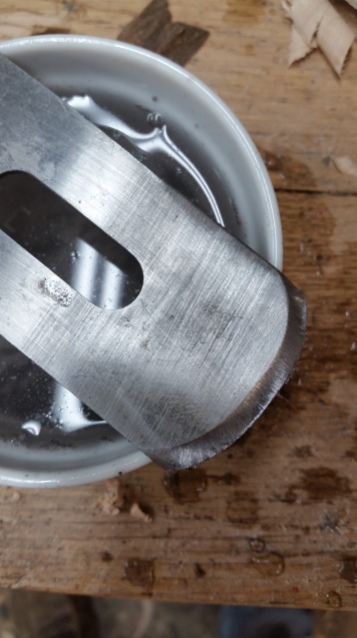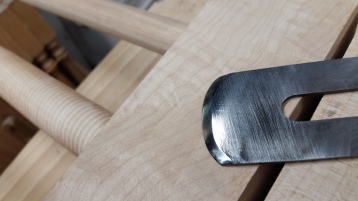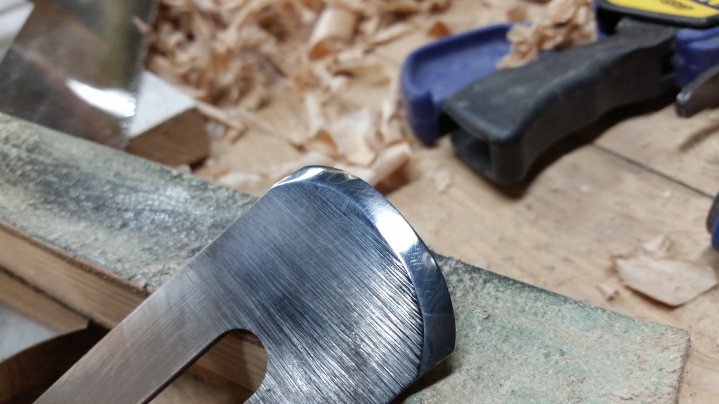Whether he intended to do it or not, in the image of the bindery from Jost Amman’s book he captured a technological evolution in the man featured prominently in the foreground. The tool he is using is a bookbinder’s plough, and it’s the iPhone of the 16th century bindery, a game changer.

This is such a groundbreaking moment for the bindery because prior to the introduction of the book plough, the edges of books were dressed with a draw knife. It was a messy process and left a telltale scalloped pattern on the edge of the pages as the binder had to saw the blade back and forth to get it across the dense sheets of stacked and compressed linen paper.
The plough is such new technology that the plough’s predecessor is till in the scene, on the floor by the ploughman’s left foot.

This is necessary because paper is thicker than we normally credit, which is magnified when you fold a stack of pages, the inner leaves will be pushed out just a bit further than the outermost leaves. To make a clean, flush, squared, edge, those thrust forward edges much be trimmed away.

The operation of the plough
The bookbinder’s plough is superficially similar to the joiner’s plough plane, except that in operation it is entirely different. Like a woodworking plough, it is a blade held in a frame with a screw-adjusted fence that keeps it on track. However, the bookbinder’s plough rides on a rail in the finishing press, acting as a fence, while the threaded center screw pulls the active face, which holds the blade perpendicular to the path of travel, into the book block a little more with each turn. Thus has a book block been squared and flush since it’s invention in the mid 16th century.

Want a nice gilded edge or foresee paintng on your fancy prayer book? You had better first invent the plough.
If it looks like a book press atop another book press, you’re right. You also probably twigged to how one evolved from the other. So it is something we’ve already built before but with a couple of relatively simple refinements (such as a blade).
A screw.

Two chops, one threaded, the other with a key to capture the screw.

And the addition of two rails to prevent the chops from “racking”, which is to say the rails keep the two faces square to each other.

Beating a ploughshare into a sword
The blade is a matter that I am less certain about. As you know, I don’t consider myself any kind of metalsmith so any project that has “Make a blade” as the next step is going to give me pause.
To complicate matters, there’s no evidence I can find as to the size or comportment of the blades prior to 1658 (see Szirmai footnote, below) or how the shapes evolved. Considering how much variation we see in other tools across the cultures, I doubt there was much consistency at all so early on. To really complicate things, the earliest description and illustration of a plough blade (remember, 100 years after Jost Amman drew his picture) is circular.
I don’t even know where to begin to find a circular blade. Maybe by the time I make my next plough, I’ll have found one somewhere. For now, I default as always to what I know when I don’t know for certain how to proceed and what I know is joiner’s planes.
An old, cheap, off-the-shelf plane blade that’s been knocking around the place is carbon steel, so I know that at least it will hold a nice enough edge to cut paper. The pre-cut holes are a boon as well for mounting it to the bottom of my plough.
I just need to grind, file, sharpen, and polish until it has a nice radius to it.
If nothing else, I chose a nice, tight, radius to give the slicing the same characteristics as a circular blade even if I couldn’t find a circular blade to use.
I’m not sure how I’m going to mount it securely and flush and perfectly square with the base of the plough yet. No one recorded how they did it either, including Szirmai’s 17th century sources. I have some good ideas and I’ve been examining every antique plough I can find pictures of on the internet to refine those ideas. I will probably lock it in place with brass and a set screw so I can easily remove it for sharpening.
I’ll let you know when I have it figured out. In the meantime, I have yet more polishing to do before I consider that blade ‘finished’ anyway and I should probably get back to it.
More later,
~ Scott
Image sourcing
Image: Der Buchbinder, woodcut from Das Ständbuch (1568) by Jost Amman, edited, highlighted, and generally cleaned-up by yours truly; original image sourced from Wikimedia Commons
Works referenced
The Archaeology of Medieval Bookbinding by J.A. Szirmai, Aldershot, 1999
“It is not known when and where the plough was invented; its first representation is in a woodcut of the interior of a bindery by Jost Amman from 1568. The earliest documentary evidence so far is a Nuremburg inventory from 1530, recording ‘zwei Beschneidehobel‘ (Helwig 1941); ‘a plowghe‘ as well as ‘a cutting Knyff‘ are listed in a Cambridge binder’s inventory from 1545 . . . the earlier type of the plough, described and illustrated in de Bray (1658) and Prediger (1741-53) has a circular knife; Zeidler mentions a narrow pointed knife, which was apparently introduced and is the only type given in the French manual of Dudin (1772). The circular knofe had the advantage that, when becoming blunt, a small turn of the knife provided a sharp new bevel without the need of readjustment.” – Szirmai






I was looking at something along the lines of this for a circular plough blade. https://www.fiskars.com.au/products/Creating/Paper-Trimmers-Blades
LikeLiked by 1 person
I have one of those at home and was experimenting with it a bit. Also my wife uses a Fiskars rotary cutter for quilting. The blades are very sharp but very thin and a bit brittle.
Rotary blades are designed to roll as they cut, so I’m not sure how much they’ll deflect under locked-down conditions (concerned about that brittleness), or even if the circular blades Szirmai was referring to were locked down or free to rotate, which is another thing I guess I should experiment with.
LikeLiked by 1 person
Good day to you,Sir,
Im a bookbinder and Im interested in make myself this kind of plough. If you be so kind, have you the plans of this plough? I mean dimensions and designs. Thank you.
LikeLike
I didn’t use plans, I’m afraid. Mine was entirely sized by the wood I had on hand, the blade I wanted to use, and the press I’d already made. For modern usage I’d probably make one with metal rods and a metal screw. Really, as long as your plough is sturdy enough to keep the blade square to the book block, and advance the blade at a steady rate each pass, you’re in good shape.
LikeLike
Thanks a lot, Sir, your advices are welcomed for me. Keep in touch.Have a nice day and be safe.
LikeLike
take a piece of all thread sandwich a large washer between 2 nuts. stick the all thread in a drill. fire up the grinder and the drill. bring the edge of the washer at your given angle into the grinder and slowly grind your cutting edge. The drill will keep the edge even and the grinder will do the rough cutting.
The modern term for this is called lapping and has been around as long as clockworks and I would expect by the middle ages was an old technology just a bit more manual.
LikeLike